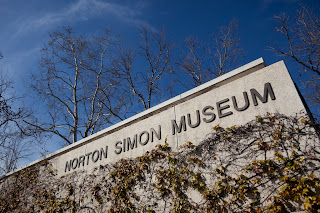|
Going Into The Field
|
Well, I finally bit the bullet and did it: I went on a Mirman field trip. I’d been putting it off all year for some reason, figuring that eventually I’d find a trip that worked with my schedule. The Norton Simon room 4 field trip came up, and I decided that I’d just go for it.
My previous experiences with field trips wasn’t exemplary. When I was in school, field trips were a day off of sorts, a chance to get out of the classroom and into an environment where the standard rules didn’t apply. I remember a particularly awful Disneyland field trip in high school (Crossroads, exploring the tightly run and dictatorial aspects of Walt’s world through a Marxist lens. This was considered normal by Crossroads standards). On that trip, two boys got stoned on the People Mover and then tried to exit during the ride; they landed in Security Land, much to the chaperones’ chagrin.
When my daughter went to Third St. Elementary, I helped out on a couple of trips before deciding that my nerves simply couldn’t take the noise level, or the fact that many of the boys seemed more interested in hitting each other than focusing on the trip at hand. Since I couldn’t really discipline the kids (and the teacher didn’t seemed inclined, either), it was a really awful time.
Mirman, however, proved to be the opposite. Tightly controlled and bound by non-negotiable rules, the kids filed in a fairly organized fashion onto the bus. The noise level was completely bearable; I sat with another mom the whole time and had a really nice time. Lunch was held across the street from the Norton Simon, and again it was so orderly you would’ve thought it was a Garden Party. There was no running around, no screaming, just kids arranged in groups on blankets happily gorging their lunches. Wow.
About a week prior to going on the trip, Anna had handed me a packet of materials, detailing each gallery and work we were to discuss with our assigned group. It was the sort of art history material that seemed better suited to an AP Art History course than a group of 4th graders, but she appeared unfazed. “Please memorize it,” she told me. I think I stuck my tongue out at her.
I was relieved to discover that none of the parents had memorized the packet. We all seemed kind of intimidated, even the dad who was an artist. I shouldn’t have worried, though. As scholarly and serious as the handout was, it was also made clear that getting through the entire thing was probably impossible, and the teacher was going to help move our groups along in a timely fashion.
I was assigned three kids (not my child. No one was matched with their own child). Three of these kids was definitely enough, because they couldn’t have been more different. I got The Dreamer, The Businesslike Scholar, and The One Who Wouldn’t Shut Up.
“What would happen if I touched this painting?” The One Who Wouldn’t Shut Up asked, stepping perilously close to a Degas.
“Really?” she asked, intrigued.
I tried to keep them moving. Luckily, The Businesslike Scholar moved into action, hunting down the paintings we were supposed to study. He was so efficient, in fact, that sometimes he even wrote about works we didn’t need to focus on. He particularly liked Brancusi.
The Dreamer had difficulty getting a word in edgewise, mostly because she kept raising her hand, something that The One Who Wouldn’t Shut Up didn’t appear to honor. The Dreamer rose to the occasion, though, once we reached Popova’s cubist masterpiece, The Traveler. Made up of bright, colorful cones, it had letters scattered within it.
“That’s Russian,” The Dreamer said, pointing to the letters. “It’s all broken up, but I can make some of it out.”
Interesting.
When I mentioned the dramatic personality differences, one parent told me I had it easy in comparison to her charges. “One of the kids said he
was going to be in charge of the group,” she said. “I had to shut that down pretty fast.”
The rest of the tour was a blur. Sit in front of this painting and write a poem based on a particular format. Discuss the differences and similarities between two Picassos painted during difference periods. Finally, free write for three minutes on the energy evoked from the nonrepresentational work of Sam Francis. Once they all settled down, it was amazing how enthusiastic they were about their work. They honestly liked it. And they really understood the concepts, which was gratifying since I was frantically trying to keep up and wasn’t sure I was doing the trip justice.
Since this is the first Mirman field trip I’ve been on, I’m not sure they’re all this rigorous. It definitely wasn’t a “free day.” It was work, it was school, and it was taken very seriously. All in all, I enjoyed it. And the kids seemed happy too. Overall, I found it refreshing that a field trip really was taken seriously as an educational opportunity. Now, my daughter seems to relate to art in a very different, much more connected way.
Even though I was apprehensive, this field trip was a positive experience. I’d definitely do it again. Although definitely NOT the Sacramento overnight; I was exhausted enough after just four hours.



Great to see an inside look at a Mirman field trip. Funny too. The arts are so important to a well rounded education.
Wow. Sounds like an awesome school! And field trip. Take me! Take me!
Thanks for joining me over at LightenUp! I think I've subscribed to your feed. Looks like a cool site!
Thanks for the inside peek!